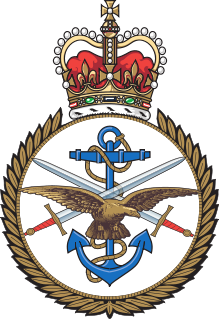
The British Armed Forces, also known as Her Majesty's Armed Forces, are the military services responsible for the defence of the United Kingdom of Great Britain and Northern Ireland, its overseas territories and the Crown dependencies. They also promote the UK's wider interests, support international peacekeeping efforts and provide humanitarian aid.

A military is a heavily armed, highly organized force primarily intended for warfare, also known collectively as armed forces. It is typically officially authorized and maintained by a sovereign state, with its members identifiable by their distinct military uniform. It may consist of one or more military branches such as an army, navy, air force, space force, marines, or coast guard. The main task of the military is usually defined as defence of the state and its interests against external armed threats.
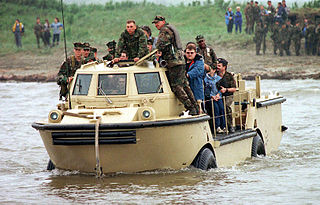
An amphibious vehicle, is a vehicle that is a means of transport, viable on land as well as on water. Amphibious vehicles include amphibious bicycles, ATVs, cars, buses, trucks, [[military [amphibious] vehicle]]s, boats and hovercraft.
Amphibious warfare is a type of offensive military operation that today uses naval ships to project ground and air power onto a hostile or potentially hostile shore at a designated landing beach. Through history the operations were conducted using ship's boats as the primary method of delivering troops to shore. Since the Gallipoli Campaign, specialised watercraft were increasingly designed for landing troops, materiel and vehicles, including by landing craft and for insertion of commandos, by fast patrol boats, zodiacs and from mini-submersibles.

The United States Department of the Navy (DN) is one of the three military departments within the Department of Defense of the United States of America. The Department of the Navy was established by an Act of Congress on 30 April 1798, to provide a government organizational structure to the United States Navy (USN), the United States Marine Corps (USMC) and, when directed by the President, the United States Coast Guard (USCG), as a service within the Department of the Navy, though each remain independent service branches. The Department of the Navy was an Executive Department and the Secretary of the Navy was a member of the President's cabinet until 1949, when amendments to the National Security Act of 1947 changed the name of the National Military Establishment to the Department of Defense and made it an Executive Department. The Department of the Navy then became, along with the Department of the Army and Department of the Air Force, a Military Department within the Department of Defense: subject to the authority, direction and control of the Secretary of Defense.

Maritime geography is often discussed in terms of three loosely defined regions: brown water, green water, and blue water.

The United States Naval Special Warfare Command (NAVSPECWARCOM), also known as NSWC or WARCOM is the Naval component of United States Special Operations Command, the unified command responsible for overseeing and conducting the nation's special operations and missions.

Power projection is a term used in military and political science to refer to the capacity of a state to deploy and sustain forces outside its territory.
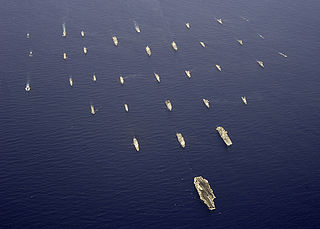
A blue-water navy is a maritime force capable of operating globally, essentially across the deep waters of open oceans. While definitions of what actually constitutes such a force vary, there is a requirement for the ability to exercise sea control at wide ranges.

Command of the sea is a naval military concept regarding the strength of a particular navy to a specific naval area it controlled. A navy has command of the sea when it is so strong that its rivals cannot attack it directly. This dominance may apply to its surrounding waters or may extend far into the oceans, meaning the country has a blue-water navy. It is the naval equivalent of air supremacy.
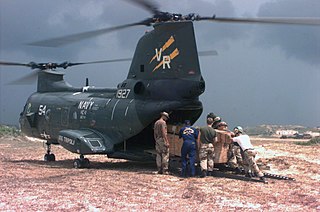
The Unified Task Force (UNITAF) was a United States-led, United Nations-sanctioned multinational force which operated in Somalia from 5 December 1992 until 4 May 1993. A United States initiative, UNITAF was charged with carrying out United Nations Security Council Resolution 794 to create a protected environment for conducting humanitarian operations in the southern half of the country.

Industrial warfare is a period in the history of warfare ranging roughly from the early 19th century and the start of the Industrial Revolution to the beginning of the Atomic Age, which saw the rise of nation-states, capable of creating and equipping large armies, navies, and air forces, through the process of industrialisation.

The Canberra class is a ship class of two landing helicopter dock (LHD) ships built for the Royal Australian Navy (RAN). Planning to upgrade the navy's amphibious fleet began in 2000, based on Australian experiences leading the International Force for East Timor peacekeeping operation. With a new climate for growing Australian Navy spending, a desire existed for forward defence capability for landing and supporting troops on Asian territory, that had never existed in Australian history, even with the old Majestic-class light fleet carriers, HMAS Melbourne and HMAS Sydney in the 1970s. In 2004, French company Direction des Constructions Navales (DCN) and Spanish company Navantia were invited to tender proposals, with DCN offering the Mistral-class amphibious assault ship and Navantia proposing the "Buque de Proyección Estratégica" design. The Spanish design was selected in 2007, with Navantia responsible for construction of the ships from the keel to the flight deck, and BAE Systems Australia handling the fabrication of the superstructure and fitting out.
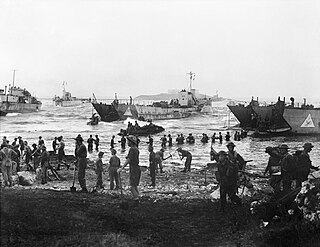
A landing operation is a military action during which a landing force, usually utilizing landing craft, is transferred to land with the purpose of power projection ashore. With the proliferation of aircraft, a landing may refer to amphibious forces, airborne forces, or a combination of both.

Green-water navy is a maritime force that is capable of operating in its nation's littoral zones and has the competency to operate in the open oceans of its surrounding region. It is a relatively new term, and has been created to better distinguish, and add nuance, between two long-standing descriptors: blue-water navy and brown-water navy.
Expeditionary warfare is the deployment of a state's military to fight abroad, especially away from established bases. Expeditionary forces were in part the antecedent of the modern concept of rapid deployment forces. Traditionally, expeditionary forces were essentially self-sustaining with an organic logistics capability and with a full array of supporting arms.
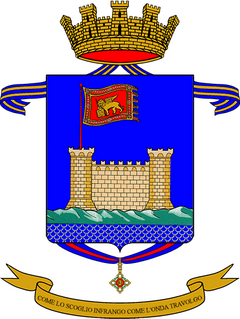
The Lagunari Regiment "Serenissima" Italian: Reggimento Lagunari "Serenissima" is the only unit of the Lagunari, the Italian Army's infantry corps' amphibious speciality. The name of the specialty comes from the Italian word for lagoon, while the regiment's name "Serenissima" commemorates the Republic of Venice. The regiment is based in Venice and part of the Cavalry Brigade "Pozzuolo del Friuli". The "Pozzuolo del Friuli" brigade forms with the Italian Navy's Third Naval Division, and San Marco Marine Brigade the Italian military's Forza di proiezione dal mare.

The United States Navy (USN) is the naval warfare service branch of the United States Armed Forces and one of the eight uniformed services of the United States. It is the largest and most capable navy in the world and it has been estimated that in terms of tonnage of its active battle fleet alone, it is larger than the next 13 navies combined, which includes 11 U.S. allies or partner nations. It has the highest combined battle fleet tonnage and the world's largest aircraft carrier fleet, with eleven in service, two new carriers under construction, and five other carriers planned. With 336,978 personnel on active duty and 101,583 in the Ready Reserve, the U.S. Navy is the third largest of the U.S. military service branches in terms of personnel. It has 290 deployable combat vessels and more than 3,700 operational aircraft as of June 2019, making it the third-largest air force in the world, after the United States Air Force and the United States Army.
The United States has a long history in amphibious warfare from the landings in the Bahamas during the American Revolutionary War, to some of the more massive examples of World War II in the European Theater of Operation on Normandy, in Africa and in Italy, and the constant island warfare of the Pacific Theater of Operations. Throughout much of its history, the United States prepared its troops in both the United States Marines and the United States Army to fight land from sea into the center of battle.

Amphibious Construction Battalion TWO is an amphibious construction battalion in the United States Navy based in Little Creek, Virginia. Amphibious Construction Battalion ONE is its sister unit based in Coronado, California.

















